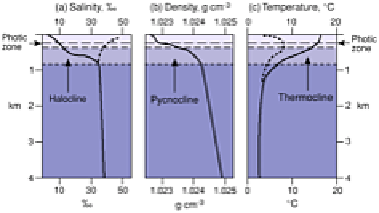Environmental Engineering Reference
In-Depth Information
thousand in freshwater estuaries to a normal ocean range between 32 and 37·5 parts per
thousand. In general, saline water is found at depth, owing to its greater density below a
halocline
isolating less saline surface waters. The halocline may coincide with the
pycnocline
, or zone of greatest density increase (Figure 11.7). However, salinity rises
Figure 11.7
Vertical stratification of the ocean with respect
to (a) salinity, (b) density and (c) temperature. Salinity may
rise rapidly towards the surface in low-latitude bays (strong
evaporation) and temperature may fall towards the surface
near freshwater and glacial inflow. Depth in km.
Source: Modified from Gross (1990).
substantially with a weak or negative water flux with the rest of the hydrological cycle
through strong evaporation, low rainfall or low freshwater influx. This raises average
salinity to 38 parts per thousand in the Mediterranean, 40 parts per thousand in the Red
Sea and staggering values of over 350 parts per thousand at depth through density settling
in the latter. The global bulk average salinity of 34·5 parts per thousand is approached
below the
thermocline
(see below) where surface heating effects are negligible.
TEMPERATURE AND STRUCTURE
Oceans exhibit both thermal and density
stratification
or layering, based respectively on
temperature and salinity. Solar radiation flux at the ocean surface strongly influences the
upper 100-200 m, which has a temperature range of 0°-30° C around a global average of
17° C (Figure 11.7). Shallow, local thermoclines may be created diurnally or seasonally
in this layer but they are susceptible to turbulent mixing by wind and ocean surface
currents. The main
thermocline
is the zone of steepest temperature gradient between 100
m and 500 m, at rates of 0·4°-0·7° C per 10 m depth. Turbulent heat exchange is not felt
below the thermocline, and ocean water assumes its stable mean temperature of −1° C to
+5° C. This prevents general thermal mixing with deep water because the surface layer is
warmer and therefore more buoyant. Modest changes in salinity have a greater impact on
density than modest changes in temperature. However, temperature ultimately controls
the pycnocline because ocean temperature range greatly exceeds salinity range.
By comparison with surface solar heating, geothermal heat flow through oceanic crust
contributes little to the thermal balance of the oceans; not even heat concentration at mid-

